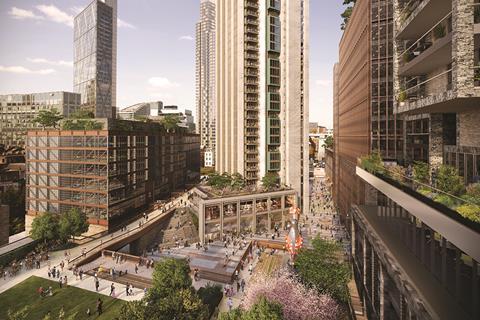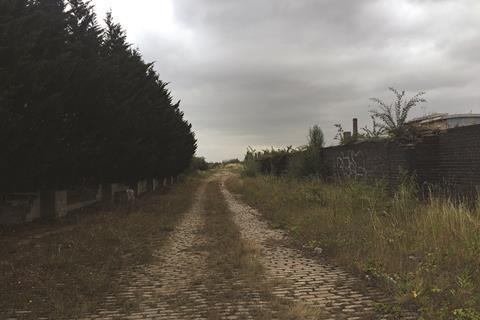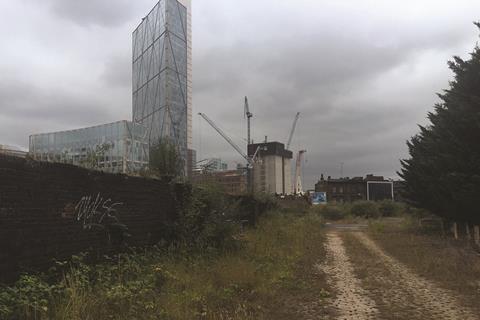The Bishopsgate Goodsyard development in east London was put on hold last month when the city’s departing mayor Boris Johnson deferred a public hearing on the planning application. The decision now falls at the feet of Sadiq Khan, in what could set a precedent for the new mayor’s planning policy
Last month the scheduled public hearing by former London mayor Boris Johnson to decide the 1,356-home Bishopsgate Goodsyard planning application was pulled, effectively casting the hugely controversial Hammerson and Ballymore scheme into something of a crisis.
The biggest shock was that Greater London Authority officers had recommended the mayor turn down the residential-led, mixed-use scheme, siding with opponents - which include both of the London boroughs in which the 4.4ha site sits - who had complained it was too dense for the location and would ruin local listed heritage. Opponents had suspected that Johnson had taken control of the planning decision out of a desire to wave the scheme through - as he had every other scheme he had called in.
But after the recommendation to refuse permission, the developers requested the mayoral decision be deferred so they could “amend the planning application to address concerns raised in the [GLA officers’] report”. For now, the 17-year scheme, originally due to start on site next year, sits in abeyance.
The new mayor, Sadiq Khan, will not thank Johnson for agreeing to the developers’ request for deferral. The crisis is a huge test of nerve for the developers, who effectively have to decide whether to stick, by tweaking their existing scheme, or twist, by going back to the drawing board with a new approach designed to win local authority and public support. With a new mayor in charge, who has made 50% affordable housing a big campaign point, there is now a real risk the whole thing could be refused. If Hammerson and Ballymore come back quickly with amends to the existing scheme, it will be a massive early test of Khan’s judgment, and one with great significance for the capital. The development encapsulates nearly all of the most highly charged issues in managing development in London: affordable housing, building at height, and response to local character. How this is managed will send a strong signal to the market about what kind of development is going to be acceptable for the four years of Khan’s mayoral term.
Upsetting the locals
A Victorian rail terminus that was turned into a goodsyard upon the construction of Liverpool Street station in 1879, the site has been largely vacant since a fire in 1964 - a hole in the dense urban fabric of Shoreditch, just north of Spitalfields market and the towers of the City of London. All sides in the dispute are keen to see it developed and it’s not hard to see why.
Tony Travers, director of the LSE London research group, says: “It’s a highly symbolic site for a number of reasons - it’s at the fringe of the City, and the heart of the new East End. It’s totemic.” But its history means the site is littered with listed railway arches and constructions, development is constrained by four train lines running over and under it, and it sits directly in an area of primarily mid-rise development of between five and eight storeys, next to a number of conservation areas.
There’s no denying the fact that even by the standards of other major developments, the 285,000m2 Goodsyard scheme has upset an extraordinary number of people. It is not, after all, every development that causes the local authority in which it sits to fund a poster campaign aimed at fomenting local opposition to it, as Hackney council has done with this. Its mayor Jules Pipe has made a number of interventions to oppose the plans. “These luxury flats, which are well beyond the reach of ordinary Londoners, will cast a shadow over the whole of Tech City [the cluster of start-up technology businesses close to Old Street’s ‘Silicon Roundabout’] and threaten to damage the local, creative economy,” he said in February last year.
Tower Hamlets, the borough for the site’s eastern half, also vigorously opposes it, alongside many heritage groups and local pressure groups - despite pledges to create a new public park and preserve much of the railway heritage.
David Donoghue, spokesperson for local opposition group More Light More Power, says: “We can’t find anyone willing to support it. It’s the wrong offices, the wrong housing and there’s no inspiration behind the scheme - nothing to be proud of.”
This confrontation is a long way from five years ago, when the developer decided to use as masterplanner the architect, Farrells, that had worked alongside Hackney and Tower Hamlets councils to draw up the approved interim planning guidance (IPG) for the site. It’s not as if a dispute was inevitable. Duncan Swinhoe, regional managing principal at architect Gensler, which has recently secured permission for a 30-storey tower nearby in Shoreditch, says: “Hackney remain a very pro-development council where it’s appropriate […] if you do something in partnership with the borough as we did.”
The most obvious reason Bishopsgate Goodsyard has caused such a stink is, of course, its density: the scheme will tower over its surroundings. The developers propose squeezing eight towers on the site, of which the tallest will rise 46 storeys. Five of the eight towers would be above 20 storeys. The developers cite the huge physical constraints of the site, primarily rail infrastructure and heritage, as justifying this: much of the site can’t be built on, so they have to go up where they can to make the scheme viable.
At the end of 2014, Hammerson’s then assistant director of development Rob Allan told Building’s sister title BD: “We’ve gone for taller buildings because of constraints. There’s only about 30% of the site where we can get piles into the ground. We’ve had to locate [the buildings] in certain parts and that’s why we’ve had to go for taller buildings.”
He said that among the issues the site faces is the Central line running underneath it, as well as a suburban railway line running out of Moorgate. Network Rail has space reserved for extra railway lines that may be required to run into Liverpool Street station.
While the Farrells-created interim planning guidance, supported by the boroughs, accepted the need for up to 2,000 homes and some high rise on the site, it differed in a number of respects from the application finally submitted. Firstly, much of the space in the western half allocated to offices is now taken by residential towers. It also said heights should step down in size, reaching “street scale” by the time they abutted on four-storey Brick Lane at the eastern end. In the planning application the building here is proposed as 16 storeys.
But it is not only height - Hackney council lists 12 principle objections, running from the impact on daylight for residents, to the overall mix of uses of the scheme, to the “severe” impact on townscape and local character.
The affordable argument
But the biggest argument has been about the provision of affordable housing. The developers originally said they would aim to make 10% of the homes affordable - next to a borough target in Hackney of 50%, and a target in the IPG of 35% on site. Asking for more, the developers said, would make the site unviable. After a huge wrangle with Hackney, which saw the borough commission its own viability appraisal and brand the developers’ assessment as full of “distortion”, “double-counting” and a “lack of transparency”, the developers eventually agreed with the GLA to up this commitment to the equivalent of 16% across the site, including a £21.9m cash payment to Hackney. For this reason, GLA officers didn’t include affordable housing among the reasons to turn it down. But Guy Nicholson, cabinet member for regeneration at Hackney council, says this is still not enough to persuade him. “Our position has always been that it’s only exceptional circumstances in which a development shouldn’t have to provide the required level of affordable housing. The scale of this site is such it requires a far greater level of tenures on site.”
Hackney’s other big concern is about the impact of a huge residential-led scheme in the middle of what is now known as “Tech City” - an aspect of British expertise feted by both Boris Johnson and prime minister David Cameron as key to the UK’s economic future. The “city fringe” planning guidance set out by Johnson to support Tech City calls for a “continued supply of employment floorspace” in the core area occupied by the Goodsyard. However, the scheme proposes twice as much floorspace for housing as it does for offices. The guidance also says new developments in the area should provide “that floorspace will be useable and viable for use by micro and small enterprises […] This should include units for occupation by small or independent commercial enterprises.” The objectors say that far from providing this, what commercial space is in the Hammerson Ballymore scheme will suit corporate occupiers, squeezing out smaller, more innovative firms.
Such was its fury that Hackney council engaged architect Gensler to draw up an alternative vision for the site that prioritised the kind of accommodation needed to support the growth of Tech City not envisaged when Farrells drew up the IPG in 2008-09. Swinhoe says Gensler’s analysis showed a viable scheme was possible, through larger floorplate but lower rise commercial buildings, that fitted in with the urban grain of the area. “Hackney’s concern was about something so residential in an area of enormous commercial importance. The key thing was to have a mix of smaller and more affordable and larger workspaces,” he says. Swinhoe’s colleague Ian Mulcahey, managing director, says: “Historically the market wouldn’t have supported a commercially led scheme in that site. But there’s an amazing cluster of firms there finding they’re running out of space. The market has changed.”
Hackney’s Nicholson says: “One of the most frustrating aspects of this is the way the market’s desire for development has been put above serious thinking about the UK’s long-term prosperity, despite both the mayor’s and the prime minister’s support for Tech City.”
Despite all of these wider concerns, the GLA’s recommendation of refusal largely came down to two somewhat technical points: the impact on listed railway heritage at one end of the site, and the overshadowing of its neighbours caused by the tall towers running right up against the northern site boundary. The officers’ report found: “In order to address the daylight/sunlight impacts […] a scheme would have to have significantly less height and massing along the north-western edge of the site.” But in doing so, it gives the developers a clear route out: “By seeking to optimise, rather than maximise development, it is considered that a revised scheme could reduce the impacts to an acceptable level,” it says.
This equivocation has worried campaigners who just want the project pulled. More Light More Power’s Donoghue says: “It’s so out of order and erroneous in many ways, it has to be rejected outright and sent back to the drawing board, and we’ve written to Sadiq Khan asking him to do so.”
So far the joint developers have been tight-lipped about how they will approach the “amending” of their application prior to resubmission. The developers declined to directly answer whether they are considering pulling together a whole new scheme, or bringing in different architects, or what their time frame is for resubmission to the mayor. However, the indications are so far they will not attempt to start again. In a statement, the joint developers said: “We are pleased that the GLA recognises the significant public benefits offered. The report acknowledges that our proposals deliver over 1,300 homes with the maximum reasonable amount of affordable housing, a good mix of uses and restoration of the site’s important heritage buildings to bring them back to life.”
The truth is the developers aren’t likely to answer these questions until they start to get some indications from City Hall about Khan’s priorities and likely attitude. Gensler’s Mulcahey says: “The developers are probably waiting to see what the new mayor’s thinking is before deciding exactly what to do next.”

The new mayor
Therefore, the site’s future is in many ways in mayor Khan’s hand. He said nothing about the scheme during the campaign, but his manifesto contained a top line pledge that 50% of new homes be affordable, and in that context he spoke out against “greedy developers”. The manifesto also pledged “greater transparency around viability assessments” and “stronger policies to ensure tall buildings respect the character of existing neighbourhoods”. Hackney’s Nicholson says: “I wouldn’t imagine he’s going to be particularly excited by this. He’s made very clear his ambitions for homes and businesses in the capital and the scheme falls far short on both of these.”
But Khan will also have to have an eye on ensuring continued delivery of housing, which could be compromised if he insists both on reducing height and delivering more affordable homes. Adam Challis, head of residential research at agent JLL, says: “It’s a pretty fixed equation. If you reduce the development value, then you reduce the quantum that can be given for affordable housing.” LSE London’s Travers says: “It’s an incredibly complex challenge for Sadiq. He can’t afford to send out a signal to the development community that everything is going to stop and be reviewed. But it would be very hard indeed with a target of 50% genuine affordable housing to approve the current scheme. This is going to be an early test of where compromise lies.”
The question for many is, if he prioritises affordable housing, what else will give in schemes like Bishopsgate to make up for it? “He’s likely to take a stronger position on affordable housing versus other outcomes - which means other public benefits may suffer,” says JLL’s Challis. “I sense a real pragmatism from his team about getting things done, and where tall buildings can be part of supply, there’s an open willingness to discuss them.”
As the political dust settles after Khan’s victory, it seems that the most immediate victim of the decision to defer is the construction industry, for whom the prospect of a start on site next year now seems a very long-odds bet.

Bishopsgate viability row
The developers’ original offer to provide up to 10% affordable housing was described by the GLA as “extremely disappointing”. It rested on a financial viability assessment prepared by consultant DS2, which found the development couldn’t actually sustain any affordable housing at all, when considered on a “present day basis”. However, Hackney and Tower Hamlets councils commissioned BNP Paribas Real Estate (BNP PRE) to review the assessment, with the firm finding DS2 couldn’t justify the required profit margin for the developer and had understated sales values. Hackney mayor Jules Pipe said of BNP PRE’s report that: “It identifies ‘distortion’, ‘double-counting’ and a ‘lack of transparency’ throughout the developers’ assessment, argues they have ramped up their costs and downplayed profits, and predicts our communities would be short-changed by the current S106 money being offered.” It found the scheme could actually viably contain 31% affordable housing plus a £12m payment in lieu to Hackney. However, the GLA then commissioned a third viability assessment, this time by Gerald Eve. This broadly came down on DS2’s side over its estimates of costs, sales value and land value, and supported BNP PRE over the rate of return the developers could expect. It found that the revised figure negotiated by the GLA officers, of 16% affordable housing made up of 141 homes and a £21.8m payment, was in fact the maximum that could “reasonably” be expected.































No comments yet